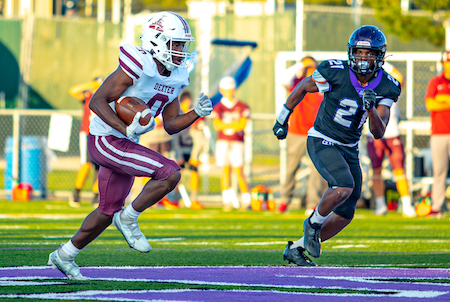Sitting in the bleachers and watching a competitive cheer competition evokes a certain appreciation for what these athletes are doing out on the mat. And what they are doing requires hours of practice and preparation – and a few falls. There is a lot of work that goes into a routine and many of the fans in those bleachers don’t realize the half of it.
So, let’s ask Makayla Gerlach to break it all down. The Dexter senior just finished her fourth year as a member of the Dreadnaughts’ successful competitive cheer team and has some interesting insight into the work that goes into those routines.
First, there are three rounds to competitive cheer. Round one consists of jumps and motions, round two is synchronized skills, and round three features stunts and tumbles.

“The biggest challenges we have when it comes to getting our routines down are memorization and timing,” Gerlach says. “For each round, we have to memorize different words, movements, and motions. This can be challenging because you have to make sure you practice a ton at home and hold each of your teammates accountable.”
Gerlach says the Dexter team’s philosophy is that you are only as strong as your weakest link. “And if a few people don’t know where to go or what motion to hit, it really can show in the scores we receive at a competition,” she says.
“Furthermore, timing is also very challenging. In our routines we have to make sure we move, stunt, tumble, and hit motions at the exact time. Usually, we spend a ton of time on this at practice because timing really matters when it comes to perfecting and cleaning up each round.”
Being in the right mood also is important.
“Once you set foot onto the mat, you must set aside anything that may be bothering you and work together with your teammates to set a good environment to practice in,” says Gerlach.

And then there is showtime, when you take all the hard work and (hopefully) make it all pay off. Gerlach admits that she gets “pretty nervous” on days they compete especially when the tournament features a number of high-profile programs – like the recent District tournament.
“At bigger competitions such as districts of course everyone is fighting for their spot at regionals so you kind of feel the pressure set in because you want every movement you make to be perfect, and that can be very hard sometimes,” Gerlach said. “Overall, I am usually pretty excited and hyped at competitions. I like to have fun while performing, and it helps when we all are in good moods because it helps set the mood for how we are going to perform.”
Gerlach tumbled into competitive cheer almost by accident. “I never was interested in cheer until my parents suggested trying it out when I moved to Dexter,” she says. “At first, I decided not to join because I didn’t think I would enjoy it, but within the next year or so I decided to join cheer on my own because I wanted to try something new and get involved in an extracurricular activity.”
And once she was in, she was all in.
“Once I began going to practice, my love for the sport grew a substantial amount,” she says. “I love cheer because of the uplifting environment. You learn tons of new things and are able to make lifelong friendships with the teammates you surround yourself with. It’s like a second family, and it isn’t like any other sport in that sense. You are really able to get to know each of your teammates, and since you spend most of your time with them at practice it is like a second home as well.”

Gerlach says this year’s Dexter team was special. And the Dreadnaughts are quickly making a name for themselves in the competitive cheer arena – they are certainly on the right path (mat).
“We all can have fun at practice while knowing when to be serious at certain points, and we also are able to talk about everything,” she said. “I don’t think there has been a moment where we haven’t overshared with each other. We are all super close, meaning everyone always knows everything about everyone. If you have an injury or are having a bad day, we all tend to tell each other those things so that we can tell what to expect from each other at practice and try to create a fun and good environment.”
Makayla, 17, tumbles to a 3.68 GPA and is a member of NHS and also plays lacrosse. “So far I am undecided about a college,” she says. “But I plan on attending a four-year university to study Kinesiology in order to become an athletic trainer.”










